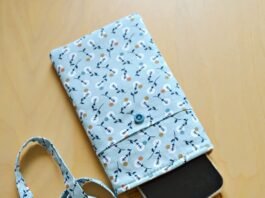Recycling fabric scraps Amazing DIY ideas using just fabric scraps- Step by Step Tutorial is a creative and sustainable way to give new life to leftover materials while making beautiful and functional projects. Every home with a sewing machine or a love for crafts tends to accumulate a pile of fabric pieces that are often too small for larger projects but too precious to throw away. Instead of letting them gather dust, these little bits of fabric can become the foundation for amazing do-it-yourself crafts that bring personality and charm into your home.
In this guide, you will not only learn how to reuse those pieces effectively but also discover practical tips for creating stylish and eco-friendly decorations. By following this step by step tutorial, you’ll realize that there are countless possibilities hidden in the scraps you once considered waste. From wall hangings to coasters, patchwork pillows to bookmarks, each idea will allow you to experiment with colors, textures, and shapes while reducing waste in an environmentally friendly way.
The beauty of recycling fabric scraps lies in its accessibility. Whether you are a beginner or an experienced crafter, these small projects are easy to start, require minimal tools, and can be adapted to your personal style. With patience and a little imagination, you will soon have unique handmade creations that not only decorate your home but also carry the satisfaction of sustainable living. Let’s explore together how to transform leftover fabric into treasures with this step by step tutorial.

Why Recycling Fabric Scraps Matters
When we talk about recycling fabric scraps Amazing DIY ideas using just fabric scraps- Step by Step Tutorial, the first thing that comes to mind is sustainability. The fashion and textile industries are among the largest producers of waste, and reusing fabric scraps at home is a simple but powerful way to contribute to reducing this problem. Each time you create something new from leftover material, you prevent it from ending up in the trash.
Another reason why fabric scrap recycling is so meaningful is the potential for creativity. Every scrap of fabric holds a story—whether from a favorite shirt, an old curtain, or a leftover quilting project. By combining these pieces, you create something entirely new that carries the memory of the original material while being transformed into a practical or decorative item.
From a financial perspective, using fabric scraps also makes sense. Craft supplies can be expensive, but when you recycle what you already have, you lower costs significantly. This makes it an ideal practice for families, hobbyists, and anyone wanting to create beautiful crafts without spending much.
The uniqueness of handmade items made from fabric scraps cannot be overstated. No two projects will ever be identical, because the combination of fabrics, colors, and patterns is always different. This adds a touch of originality to your home decor, making every corner feel warm and personalized.
Additionally, working with fabric scraps is a wonderful way to improve your sewing and crafting skills. Since you are using small pieces, you can experiment freely without the pressure of wasting expensive materials. Every project becomes an opportunity to learn new techniques and gain confidence.
Finally, recycling scraps can inspire others around you. Whether it’s children learning the value of reusing materials or friends admiring your handmade creations, these small projects can spark conversations about sustainability and creativity.
Creative DIY Ideas with Fabric Scraps
When following the recycling fabric scraps Amazing DIY ideas using just fabric scraps- Step by Step Tutorial, you will see how versatile these little pieces of fabric can be. One of the simplest and most charming ideas is to create patchwork coasters. By sewing small squares or strips together, you can make colorful and practical items that protect your table while showcasing your creativity.
Another beautiful project is a fabric scrap wall hanging. This is an excellent way to decorate a blank wall in your home with a piece that is both artistic and meaningful. By layering different textures and patterns, you create a unique statement piece that reflects your personal taste.
Fabric scraps can also be turned into decorative pillows. By combining different prints and colors, you can create patchwork designs that add warmth and coziness to your living room or bedroom. This is especially great when you want to refresh your space without spending money on new decorations.
Bookmarks made from fabric scraps are another delightful DIY idea. By sewing or gluing small strips of fabric onto cardstock or felt, you create colorful and durable bookmarks perfect for personal use or as thoughtful gifts for book lovers.
If you have children, fabric scraps are perfect for making small toys or dolls. Simple stuffed animals, hearts, or stars can be sewn together quickly and provide hours of joy while also teaching kids about recycling.
Lastly, don’t overlook the beauty of fabric scrap garlands. These can be used to decorate parties, children’s rooms, or even as seasonal decor. By tying strips of fabric to a string, you create a charming and festive decoration that is easy to make and fully customizable.
Step by Step Tutorial for Beginners
Now let’s dive into a step by step tutorial to help you start your journey with recycling fabric scraps Amazing DIY ideas using just fabric scraps- Step by Step Tutorial. First, gather all the fabric scraps you have on hand. Sort them by size, color, and material, as this will make it easier to plan your projects and combine pieces effectively.
Next, choose a simple project to begin with. For beginners, coasters or bookmarks are the perfect starting points. They require minimal sewing skills and can be completed quickly, giving you a sense of accomplishment that motivates you to keep going.
Once you’ve chosen your project, cut the fabric scraps into the necessary shapes. For example, if you are making coasters, cut equal-sized squares or circles. Use a rotary cutter or sharp scissors to ensure clean edges.
After cutting, arrange the pieces to see how the colors and patterns look together. This step is important for creating a harmonious design. Don’t be afraid to mix bold prints with neutral tones—sometimes the most unexpected combinations turn out beautifully.
Sew or glue the pieces together depending on your chosen method. If sewing, make sure to use a straight stitch for clean lines. If gluing, choose a strong fabric adhesive to ensure durability. Add a piece of felt or thicker fabric as backing to give your project stability.
Finally, finish the edges neatly. You can sew around the border, add decorative stitches, or even use fabric paint to enhance your creation. The finishing touch makes your DIY project look polished and professional.
Tips for Success and Inspiration
When working with recycling fabric scraps Amazing DIY ideas using just fabric scraps- Step by Step Tutorial, there are a few tips to keep in mind that will make the process easier and more enjoyable. First, always keep your scraps organized. Having a dedicated box or drawer for different types of fabric will save you time and frustration when starting new projects.
Experiment with mixing textures. Combining cotton with denim, linen with lace, or felt with printed fabric creates depth and interest in your projects. Don’t be afraid to play with contrasts, as they often result in the most striking designs.
Another tip is to use fabric scraps as accents rather than the main material. For instance, you can add a strip of colorful fabric to a plain pillowcase or use scraps to create appliqué designs on tote bags and clothing. This way, you refresh old items without completely remaking them.
If you’re aiming for durability, reinforce your projects with a backing fabric or lining. This is especially important for items like bags, pillows, or toys that will be used often. Reinforcement ensures your project lasts longer and withstands daily use.
Take inspiration from seasonal themes. For example, red and green scraps can be used to make Christmas decorations, while pastel scraps are perfect for springtime crafts. This keeps your projects fresh and relevant throughout the year.
Finally, remember that practice makes perfect. The more projects you complete, the more confident and skilled you’ll become. Each new item adds to your creative journey, and soon you’ll be able to design your own original ideas with ease.
FAQ About Recycling Fabric Scraps
1. What can I make with small fabric scraps?
You can make coasters, bookmarks, garlands, small toys, appliqués, and even jewelry like fabric-covered beads.
2. Do I need a sewing machine to recycle fabric scraps?
No, many projects can be completed with fabric glue, hand stitching, or no-sew techniques. A sewing machine is helpful but not required.
3. How do I store fabric scraps properly?
Sort scraps by size, color, and type of fabric. Store them in clear boxes or labeled bags to make them easier to find.
4. Can fabric scraps be used for clothing?
Yes, larger scraps can be turned into patchwork skirts, tops, or accessories. Smaller pieces are ideal for appliqué and decorative touches.
5. Are recycled fabric projects durable?
Yes, if you reinforce seams and use proper techniques, fabric scrap projects can be just as durable as those made with new materials.
6. Why is recycling fabric scraps eco-friendly?
It reduces textile waste, limits the need for new materials, and promotes sustainable living by making the most of what you already have.
Conclusion
In this article, we explored recycling fabric scraps Amazing DIY ideas using just fabric scraps- Step by Step Tutorial, showing how simple it is to transform leftover fabric into unique and useful creations. From coasters to wall hangings, pillows to garlands, the possibilities are endless when you let your creativity guide you.
By following the step by step tutorial and applying the tips shared here, you can make eco-friendly and personalized decorations that add charm to your home while reducing waste. Remember, every small project contributes to a more sustainable lifestyle.
We hope this guide has inspired you to start your own recycling journey. Share your thoughts in the comments, let us know what projects you’ve tried, and feel free to suggest new ideas we can explore together. Your opinion matters and helps us create even more useful and inspiring content for you.





